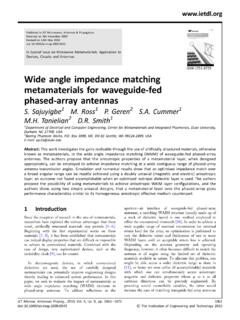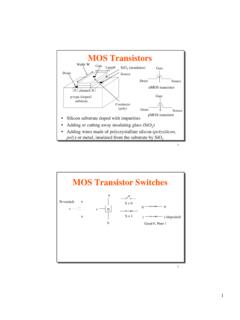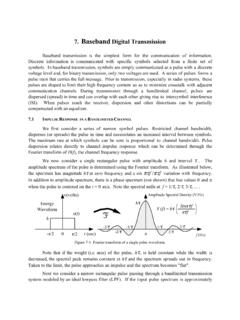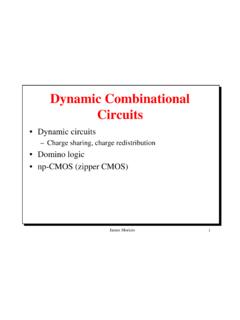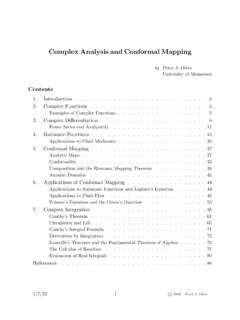Transcription of The group lasso for logistic regression
1 J. R. Statist. Soc. B (2008). 70, Part 1, pp. 53 71. The group lasso for logistic regression Lukas Meier, Sara van de Geer and peter B hlmann Eidgen ssische Technische Hochschule, Z rich, Switzerland [Received March 2006. Final revision July 2007]. Summary. The group lasso is an extension of the lasso to do variable selection on (predefined). groups of variables in linear regression models. The estimates have the attractive property of being invariant under groupwise orthogonal reparameterizations. We extend the group lasso to logistic regression models and present an efficient algorithm, that is especially suitable for high dimensional problems, which can also be applied to generalized linear models to solve the corresponding convex optimization problem. The group lasso estimator for logistic regression is shown to be statistically consistent even if the number of predictors is much larger than sam- ple size but with sparse true underlying structure.
2 We further use a two-stage procedure which aims for sparser models than the group lasso , leading to improved prediction performance for some cases. Moreover, owing to the two-stage nature, the estimates can be constructed to be hierarchical. The methods are used on simulated and real data sets about splice site detection in DNA sequences. Keywords: Categorical data; Co-ordinate descent algorithm; DNA splice site; group variable selection; High dimensional generalized linear model; Penalized likelihood 1. Introduction The lasso (Tibshirani, 1996), which was originally proposed for linear regression models, has become a popular model selection and shrinkage estimation method. In the usual linear regres- sion set-up we have a continuous response Y Rn , an n p design matrix X and a parameter vector Rp . The lasso estimator is then de ned as . p = arg min. Y X 22 + | j |/, j=1. where u 22 = ni=1 u2i for a vector u Rn . For large values of the penalty parameter , some com- ponents of are set exactly to 0.
3 The l1 -type penalty of the lasso can also be applied to other models as for example Cox regression (Tibshirani, 1997), logistic regression (Lokhorst, 1999;. Roth, 2004; Shevade and Keerthi, 2003; Genkin et al., 2007) or multinomial logistic regression (Krishnapuram et al., 2005) by replacing the residual sum of squares by the corresponding negative log-likelihood function. Already for the special case in linear regression when not only continuous but also categorical predictors (factors) are present, the lasso solution is not satisfactory as it only selects individ- ual dummy variables instead of whole factors. Moreover, the lasso solution depends on how the dummy variables are encoded. Choosing different contrasts for a categorical predictor will produce different solutions in general. The group lasso (Yuan and Lin, 2006; Bakin, 1999; Cai, 2001; Antoniadis and Fan, 2001) overcomes these problems by introducing a suitable extension Address for correspondence: Lukas Meier, Seminar f r Statistik, Eidgen ssische Technische Hochschule Z rich, Leonhardstrasse 27, CH-8092 Z rich, Switzerland.
4 E-mail: 2008 Royal Statistical Society 1369 7412/08/70053. 54 L. Meier, S. van de Geer and P. B hlmann of the lasso penalty. The estimator is de ned as . G. = arg min. Y X 22 + Ig 2 /, g=1. where Ig is the index set belonging to the gth group of variables, g = 1, .. , G. This penalty can be viewed as an intermediate between the l1 - and l2 -type penalty. It has the attractive property that it does variable selection at the group level and is invariant under (groupwise) orthogonal transformations like ridge regression (Yuan and Lin, 2006). This paper deals with the group lasso penalty for logistic regression models. The logistic case calls for new computational algorithms. Kim et al. (2006) rst studied the group lasso for logistic regression models and proposed a gradient descent algorithm to solve the correspond- ing constrained problem. We present methods which allow us to work directly on the penalized problem and whose convergence property does not depend on unknown constants as in Kim et al.
5 (2006). Our algorithms are ef cient in the sense that they can handle problems where p and n are large. Furthermore, they are also applicable to generalized linear models, beyond the case of logistic regression . We do not aim for an (approximate) path following algorithm (Rosset, 2005; Zhao and Yu, 2004; Park and Hastie, 2006, 2007) but our approaches are suf ciently fast for computing a whole range of solutions for varying penalty parameters on a ( xed) grid. Our approach is related to Genkin et al. (2007) which presented an impressively fast implementation ( the fastest') for large-scale logistic regression with the lasso ; in fact, we can also deal with dimensionality p in the 10 000s but now for the group lasso . Moreover, we present an asymp- totic consistency theory for the group lasso in high dimensional problems where the predictor dimension is much larger than the sample size. This has neither been developed for linear nor for logistic regression .
6 High dimensionality of the predictor space arises in many applications, in particular with higher order interaction terms or basis expansions for logistic additive models where the groups correspond to the basis functions for individual continuous covariates. Our application about the detection of splice sites, the regions between coding (exons) and non-cod- ing (introns) deoxyribonucleic acid (DNA) segments involves the categorical predictor space {A,C,G,T}7 which has cardinality 16 384. The rest of this paper is organized as follows. In Section 2 we restate in more detail the idea of the group lasso for logistic regression models, present two ef cient algorithms which are proven to solve the corresponding convex optimization problem and compare them with other optimization methods. Furthermore, we show that the group lasso estimator is statistically con- sistent for high dimensional sparse problems. In Section 3 we outline a two-stage procedure which often produces more adequate models in terms of both model size and prediction per- formance.
7 Simulations follow in Section 4 and an application of the modelling of functional DNA sites can be found in Section 5. Section 6 contains the discussion. All proofs are given in Appendix A. 2. logistic group lasso Model set-up Assume that we have independent and identically distributed observations .xi , yi /, i = 1, .. , n, of a p-dimensional vector xi Rp of G predictors and a binary response variable yi {0, 1}. Both categorical and continuous predictors are allowed. We denote by dfg the degrees of free- dom of the gth predictor and can thus rewrite xi = .xi,1T , .. , xT /T with the group of variables i,G. xi,g R , g = 1, .. , G. For example, the main effect of a factor with four levels has df = 3. df g whereas a continuous predictor involves df = 1 only. group lasso for logistic regression 55. Linear logistic regression models the conditional probability p .xi / = P .Y = 1|xi / by . p .xi /. log = .xi /, .2:1/. 1 p .xi /.
8 With . G. T..xi / = 0 + xi,g g , g=1. where 0 is the intercept and g Rdf g is the parameter vector corresponding to the gth predic- tor. We denote by Rp+1 the whole parameter vector, = . 0 , T T T. 1 , .. , G / . The logistic group lasso estimator is given by the minimizer of the convex function . G. S . / = l. / + / g 2 , .2:2/. g=1. where l. / is the log-likelihood function, n l. / = yi .xi / log[1 + exp{ .xi /}]: i=1. The tuning parameter 0 controls the amount of penalization. Note that we do not penalize the intercept. However, as shown in lemma 1, the minimum in equation ( ) is attained. The function s. / is used to rescale the penalty with respect to the dimensionality of the parameter vector g . Unless stated otherwise, we use / = df1=2. g to ensure that the penalty term is of the order of the number of parameters dfg . The same rescaling was used in Yuan and Lin (2006). Lemma 1. Assume that 0 < ni=1 yi < n. For > 0 and > 0 for all d N, the minimum in optimization problem ( ) is attained.
9 The rst condition in lemma 1 is a minimal requirement for the observed data. If the design matrix X has full rank, the minimizer of S . / is unique. Otherwise, the set of minimizers is a convex set whose elements correspond to the same minimum value of S . /. The groupwise' l2 -norm in equation ( ) is an intermediate between the lasso and the ridge penalty function. It encourages that in general either g = 0 or g,j = 0 for all j {1, .. , dfg }, where we have omitted the index for easier notation. A geometrical interpretation of this special sparsity property was given in Yuan and Lin (2006). An example of a solution path { } 0 for a model consisting of an intercept and two factors having 3 degrees of freedom each is depicted in Fig. 1. Let the n dfg matrix Xg be the columns of the design matrix corresponding to the gth pre- dictor. If we assume that the block matrices Xg are of full rank, we can perform a (blockwise). orthonormalization by a QR-decomposition to obtain XgT Xg = Idf g , g = 1.
10 , G. Using such a design matrix, the group lasso estimator does not depend on the encoding scheme of the dummy variables. We choose a rescaled version XgT Xg = nIdf g to ensure that the parameter estimates are on the same scale when varying the sample size n. After parameter estimation, the estimates must be transformed back to correspond to the original encoding. Algorithms for the logistic group lasso Block co-ordinate descent Parameter estimation is computationally more demanding than for linear regression models. The algorithm that was presented in Yuan and Lin (2006) sequentially solves a system of (neces- 56 L. Meier, S. van de Geer and P. B hlmann Parameter estimates max Fig. 1. Solution path { } 0 for a model consisting of an intercept ( .. ) and two factors having 3. degrees of freedom each ( , ): max is the value of the penalty parameter such that no penal- ized group is active in the model sary and suf cient) non-linear equations which corresponds to a groupwise minimization of the penalized residual sum of squares.
